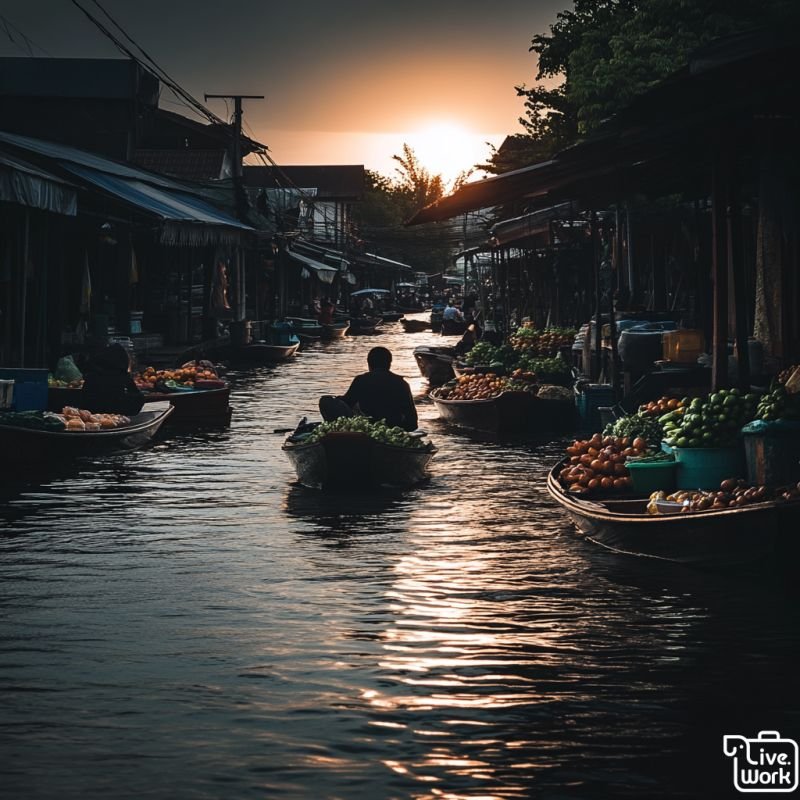Thailand’s Floating Markets: Where Culture, Commerce, and Tradition Flow Together
Imagine gliding through narrow canals lined with lush greenery, your boat drifting past colorful wooden vessels stacked high with tropical fruits, aromatic spices, sizzling snacks, and handmade goods. Welcome to the floating markets of Thailand—living symbols of the country’s rich heritage, agricultural roots, and riverside rhythms.
These iconic markets aren’t just postcard-perfect—they are authentic windows into traditional Thai life, offering an unforgettable blend of food, culture, and community.
🚣♀️ What Are Floating Markets?
Floating markets are open-air markets conducted on or near water, where vendors sell their goods directly from boats. They originated in an era when Thailand’s extensive canal (klong) network served as the primary mode of transport and trade.
Today, these markets remain both cultural landmarks and working marketplaces, where locals and visitors converge for a taste of Thailand’s timeless waterside charm.
🛍️ What to Expect at a Floating Market
Floating markets are sensory playgrounds, where every turn reveals something new:
Boats overflowing with mangoes, coconuts, bananas, and durian—often freshly cut and served right to your boat.
Sizzling street food stalls on the shore offering pad thai, grilled seafood, coconut pancakes, and more.
Vendors in traditional hats, skillfully steering their boats while calling out to customers with warmth and humor.
Handcrafted souvenirs, from woven baskets to herbal soaps and hand-dyed textiles.
Floating markets are not just about what you buy—it’s about how you experience Thai hospitality, tradition, and everyday life.
🌊 Top Floating Markets in Thailand
1. Damnoen Saduak Floating Market (Ratchaburi)
Most famous and photogenic, often featured in travel shows and movies.
Lively and bustling, especially in the morning.
Best for first-time visitors looking for the classic floating market experience.
Tip: Arrive early (around 7:00–8:00 AM) to avoid crowds and heat.
2. Amphawa Floating Market (Samut Songkhram)
Quainter and more local than Damnoen Saduak.
Operates mainly on weekends, with evening boat rides to see fireflies.
Offers a charming riverside village vibe with great seafood and coffee.
Best for: Travelers seeking a more authentic, less touristy market.
3. Taling Chan Floating Market (Bangkok)
A smaller, more relaxed market located just a few kilometers from central Bangkok.
Ideal for day trips without leaving the city.
Popular for boat-side seafood grills and foot massages under shady trees.
4. Khlong Lat Mayom (Bangkok)
One of Bangkok’s hidden gems, favored by locals.
Combines a floating market with a land-based one for a rich variety.
Friendly vendors and low prices make it ideal for casual explorers.
🍜 What to Eat at a Floating Market
Thai floating markets are culinary heavens. Don’t miss:
Boat noodles (kuay teow rua) served right from the water.
Grilled river prawns and fried fish cakes.
Sticky rice with mango, made fresh to order.
Coconut ice cream served in coconut shells.
Local herbal drinks like butterfly pea juice or pandan iced tea.
Bring cash and a big appetite—sampling is half the fun!
📷 Tips for Visiting Floating Markets
Go early for the best selection and fewer crowds.
Bring small bills for easier transactions.
Negotiate politely—haggling is expected but done with a smile.
Hire a long-tail boat for a guided canal tour.
Dress comfortably and stay hydrated—mornings can get warm quickly.
💡 Why Floating Markets Matter
Floating markets are more than tourist attractions—they're living museums of Thailand’s rural and riverside heritage.
They support local economies and preserve traditional livelihoods.
They offer a platform for generational knowledge, from cooking methods to artisan crafts.
They remind us of a time when life was lived in harmony with the water.
By visiting respectfully and spending locally, you help sustain these cultural treasures for generations to come.
Final Thoughts: Let the Markets Move You
A visit to a Thai floating market is a journey through the senses—and through time. It’s where nature, culture, and commerce intertwine in beautiful, fluid harmony. Whether you’re hunting for souvenirs, snacking on local delicacies, or simply watching the world float by, the experience will leave you with stories, smiles, and perhaps a boatload of inspiration.
